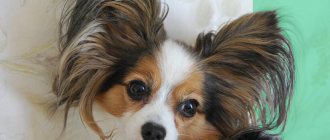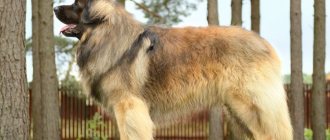Dogs with airy, furry ears and intelligent looks cannot help but charm with their appearance and behavior. Even the rulers of France could not resist the charm of miniature continental toy spaniels. Where did this breed come from and what can you expect from the “dogs of kings”?
History of the origin of the breed
The dwarf spaniel was first mentioned as a companion of European kings and noble people already in the 11th century. Many Belgian and French kings kept this small but intelligent dog with large floppy ears. Starting from the 15th century, dwarf spaniels began to leave France and appeared in Poland, Sweden, and Denmark. The real evidence of the long-standing existence of the breed is the numerous surviving paintings, engravings and frescoes in which these dogs are found.
The name of the breed – “butterfly dog” – is attributed to Queen Marie Antoinette of France. One of her four-legged companions accompanied her even in captivity - the dwarf spaniel brightened up the last days of the prisoner until her execution. After the Great French Revolution, the breed in Europe began to be destroyed as an element of luxury and one of the symbols of royal power. The salvation for spaniels was the emigration of French aristocrats to America, who tried to take their shaggy pets with them.
Important! Since the 19th century, the fashion for small dogs has been revived throughout Europe. Breeders from different countries (Belgium, France, England) tried to improve the breed by infusing new blood. This is how the toy spaniel with erect ears appeared, which was called papillon (papillon - “butterfly”), and its brother with hanging ears is called phalene (phalene - “moth”).
Description of the breed with photos
In the breed standard, the countries of origin of the continental toy spaniel are indicated as France and Belgium (it is not possible to establish more precisely due to the long-standing history). The main purpose is a companion, decorative dog. Although the name of the breed contains the word “spaniel”, which is associated with hunting dogs, the Papillon and Phalene are not used in this capacity.
If the Toy Spaniel breed is described in a few phrases, then it is a small dog with long hair, a cheerful character and an elegant bone structure. Let us dwell on the description of the breed in more detail.
The Continental Spaniel's head is small and rounded. The muzzle is almost sharp, the transition from the forehead to the muzzle is clearly defined. Nose is black. The eyes are round, dark, and set low. The lips are thin and have a scissor bite. The ears are thin, large, erect in Papillon Toy Spaniels, semi-erect in Phalene Spaniels; widely spaced. The ears have long hair, the so-called “fringe”. The neck is set high, the chest is deep. The stomach is tucked, the back is straight. The limbs are straight, parallel, fairly short, fine-boned. The tail is covered with long, thick hair, set high, and carried over the back.
The closest relative is the dwarf German Spitz.
Size and weight
The Continental Toy Spaniel is a small breed due to its size. Weight ranges from 1.5 to 4.5 kg, with two weight categories distinguished: standard dogs weigh 2.5-4.5 kg, and mini dogs weigh 1.5-2.5 kg. Height 20-28 cm , There are no mandatory values, but in general the physique should look harmonious.
Color and coat type
The standard allows two types of colors for Papillons and Phalenes: two-color and three-color. Moreover, the predominant color should be white, but spots must stand out on it. The spots can be anything (large, small, red, black, etc.), but not blue. White ears are not welcome, but a white streak (vein) on the face is desirable, and the spots on its sides should be symmetrical.
There are three possible colors:
- black and white;
- white and sable;
- tricolor (a mixture of white, black and sable).
Of all the puppies, ordinary amateur buyers choose three-colored pets, and breeders prefer two-colored animals for future breeding.
Like many other spaniels, the Continental Toy Spaniel (Papillon and Phalene) has “freckles” on the face and paws, that is, dotted spots on the main background, but they are not required.
The coat of continental toy spaniels is silky, quite long, reaching 7 cm. On the ears and tail, the hairs grow up to 15 cm. On the back sides of the legs, the elongated hair forms “pants”. This type of coat requires daily care. The shortest hairs are on the muzzle and the front sides of the paws. There is no undercoat.
Varieties of the Toy Spaniel breed
Depending on the structure of the ears, two varieties of continental toy spaniel are distinguished. The erect ears belong to the Papillons (a newly bred breed), and the semi-erect ears belong to the Phalenes (thus the royal dwarf spaniels). Papillons have long hair covering the entire inner side of the open, erect ear. Fans of the breed prefer Papillons. There is a cross between Phalene and Papillon, in which the ear is open, but not overgrown with hair, or, for example, only a small tip of the ear hangs down. These features are considered a disadvantage of the breed.
There are also varieties in the description of the spaniel breed, or subspecies: depending on the weight, standard and mini continental toy spaniels are distinguished.
Papillon Phalen
Kooikerhondje (Dutch)
The second name is Kooiker, Dutch spaniel. This is a rather rare dog belonging to the group of gundogs. Translated, the name sounds like “duck hunter,” but the dogs themselves do not hunt, they only drive the prey into a trap, where the hunter takes action. The white tail of the pet becomes a “bait” for waterfowl, but the reason why it is so attractive has not yet been established.
Features of this smooth-haired spaniel:
- Height is 34-40 cm, and weight is 9-13 kg.
- The body is of medium size, muscular, strong, proportional.
- A massive elongated head on a graceful neck.
- The ears are long and set high. Black guard hairs – “earrings” – are obligatory.
- The paws are strong but neat.
Dutch pets have a good-natured disposition, but are sometimes very trusting, so from an early age they need to be taught to clearly differentiate people into “friends” and “strangers.”
We suggest you familiarize yourself with Changing teeth in puppies
Health and illness
In general, toy spaniels have excellent health. There are some diseases that appear in them more often than others. This is a subluxation of the patella, progressive retinal atrophy. To minimize these diseases, dogs are tested in specialized kennels. Only individuals in excellent health are allowed for further breeding.
All puppies, upon reaching the age of one month, begin to receive mandatory vaccinations against rabies, distemper, and enteritis. After purchasing a puppy with its first vaccinations, the new owner must strictly adhere to the schedule of subsequent vaccinations, including revaccinations. Before vaccination, the dog is dewormed. Communication with a veterinarian in the first year of a pet’s life is frequent; this is necessary to preserve the health and life of your four-legged friend.
Lifespan
If the vaccination schedule is followed, with proper nutrition and maintenance of pets, their life expectancy reaches 12-15 years .
Character and intelligence
In terms of intelligence, the continental toy spaniel is always placed in the overall top and among the leaders among decorative breeds. In terms of ability to train, the ability to quickly and correctly make independent decisions, and early socialization, Papillons (continental toy spaniels in general) are superior to other decorative dogs. They are second only to poodles. Both of them are hunting dogs, which by nature have well-developed intuition, intelligence, an obedient character, are human-oriented, and lack aggression.
Attitude towards children and others
Papillons and Phalenes are gentle and affectionate in the family, they love noisy and active games, especially with children. They often become good watchmen, signaling with a voice the arrival of strangers or the appearance of strange animals. Dogs are brave in everyday life and in stressful situations, and cowardice for toy spaniels is a disqualifying fault.
Tibetan Spaniel
This subclass of spaniel originated in China. The Tibetan Spaniel is considered to be man's best friend. They are very reliable and loyal, and have a sharp mind. This breed is cheerful, cheerful and playful. Dogs of this breed quickly become attached to their owners; they treat strangers with caution, but do not show any malice towards them. They love free space, but if they are locked in a room they experience physiological and mental disorders. The spaniel is approximately 24 cm tall and weighs no more than 6 kilograms. The dog does not reach large sizes, but this does not prevent them from standing up for themselves. These beautiful small pets sometimes take part in fighting rings and are also great for guard roles.
The Tibetan Spaniel's muzzle is slightly shortened, its ears are set high, its back straight and short limbs are characteristics that characterize the breed. The color of the coat can be completely different. See photos of the Tibetan spaniel below.
Training and education
Training a Continental Toy Spaniel will be a real pleasure for any owner. This breed is one of the most intelligent, quick-witted, and picks up commands on the fly. The intelligence of Papillons puts them at the top of dog ratings in terms of their ability to train and speed of learning commands. With proper upbringing, a toy spaniel becomes obedient and can sense the mood of its owners.
Socialization of a Papillon or Phalene puppy begins from the moment it arrives in the house. They introduce you to all family members, and if there are any, then to other pets. The breed, which is non-aggressive by nature, quickly joins any team and becomes a full-fledged member of it. From the first days, the puppy is taught to use a litter box, and after quarantine - to walk outside, be sure to be given a personal sleeping place (bed, rug), and bowls. Begin training with simple commands. If there is no experience, the owner can attend the “General Training Course” (GTC) with his dog, where he will be taught basic commands. In the future, you can move on to sports games with a ball, disk, and learn tricks.
By the way: Papillons perform well in circus shows. They not only quickly learn tricks, but also enjoy communicating with their owner and the people around them.
English springer
The breed can be called the progenitor of all living Spaniels - the most ancient companion and hunter of the English nobility is the Springer. A large dog, reaches 46-56 cm at the withers and weighs up to 30 kg. Stately, muscular, strong, but graceful in movement, light and fast. Dogs were especially popular during the Renaissance: great artists painted them on canvas and described them in novels.
A good family pet: kind, loyal, active, devoted. The best friend for children, a partner for running and playing. Suitable for active people with free time for walking and hunting.
Springers cannot be left alone for a long time: they begin to whine, bark, and destroy everything around them. Recently, there has been a tendency towards increased incidence of rage syndrome. This is a neurological disease related to epilepsy. At the moment of an attack, the dog does not distinguish between commands and does not understand where it is, and attacks its owners for no reason.
Pros and cons of the breed
The advantages of the breed include:
- Small in size, the pet is suitable for keeping in an apartment of any size.
- Developed mind, quick training.
- Friendliness, playfulness, affection, lack of aggression.
Among the shortcomings, owners most often mention the need for daily coat care, and sometimes an excessive love for outdoor games. If raised incorrectly, a dog acquires unpleasant qualities: chews shoes, barks a lot, steals food from the table, etc.
Maintenance, care and nutrition
Small dogs are much less troublesome than large dogs. A toy spaniel does not need much space, it eats little, and if there are no walks, it can easily go to the indoor litter box. However, before buying such a dog, you need to know all the intricacies of caring for them and keeping them in the house.
The Continental Toy Spaniel loves to frolic, run and play. Of course, he needs walks, but if there is enough space in the house for games, then short walks will be enough, 15-30 minutes twice a day.
Long hair requires daily attention. It needs to be combed, preferably daily, avoiding tangles. The spaniel's coat does not have a distinct dog smell, so the dog should be washed only when necessary - after heavy soiling or before participating in exhibitions. The toy spaniel does not need haircuts; only show dogs undergo contour correction of their “hairstyle” before the show.
The ears are cleaned once a week, cutting off the hair from the ear canal so that wax does not stagnate there. Dirt and wax from the ear canal are cleaned with a cotton pad or cotton swab dipped in hydrogen peroxide. The eyes must be wiped once a week, if necessary - daily. Nails are trimmed with a guillotine/sickle clipper monthly or as they grow back.
Attention! You need to trim your nails very carefully, especially if they are black. A dog's claw is not completely hollow; it is almost half filled with a core that has vessels and capillaries. In white claws, the pink core is visible to the light. If a claw is injured, the wound is treated with hydrogen peroxide. You can sign up for your first nail trimming procedure at a dog beauty salon.
Each owner chooses the method of feeding a toy spaniel himself. This is either natural food or ready-made food. When eating natural foods, you need to ensure that your diet is complete so that it contains all the necessary microelements and vitamins.
Main products: cottage cheese, eggs, cereals, lean meat, boneless fish, vegetables plus vitamin complexes. It is easier to feed your dog ready-made food (dry or wet), which contains all the required substances. The dwarf toy spaniel eats little, so feeding it with ready-made food from good companies will not be very expensive. Whatever feeding method you choose, water should always be freely available! It is forbidden to feed sweet, smoked, salty, fatty foods, as well as any bones.
To maintain healthy teeth, you need to brush them once every 3 days with a special toothbrush and edible paste. If you give your pet hard treats, for example, compressed ears, sinews, then you can brush your teeth less often. When a dog chews on such treats, they mechanically wear away tartar.
Field Spaniel
The birthplace of this breed dates back to the 19th century in Great Britain. The Field Spaniel is a beautifully proportioned dog. The character is flexible and balanced. Very hardy and obedient. Well amenable to training.
The height of the Field Spaniel is not very large, approximately 46 cm, the weight of an adult dog is 16 - 30 kg. The body is medium in size, strong back, limbs are long and strong. The spaniel's head is elongated, the occipital protrusion is clearly defined, the eyes are dark brown, almond-shaped. The ears hang down and are completely covered with fur. The tail is located low, it is docked to a third of the total length. The smooth and shiny coat requires daily brushing, otherwise it will tangle and spoil the dog's appearance.
The coat color ranges from black to brown, and there are also red-brown markings.
How to choose a puppy
The main rule for choosing a good puppy is that you need to purchase it from specialized nurseries or from trusted, reputable breeders. Buying a puppy from private hands is a blind purchase. Conscientious breeders sell puppies with their first vaccinations, with a veterinary passport, and with a puppy card. Such sellers give recommendations on feeding and raising the puppy, accompany the owner in the future, and help find partners for future breeding.
In each litter from parents with good pedigree, the owners divide the puppies into three categories. Pet class is suitable for use only as a pet; such puppies have a slight breed defect (disqualifying sign: inappropriate color, crease in tail, malocclusion, etc.). Pet puppies are excluded from further breeding; they are cheaper than others. The breed class meets all breed standards and is suitable for breeding and exhibition career.
The price is average. Show class is assigned to puppies with excellent exterior characteristics. These dogs have a career prospect at international exhibitions, they are capable of becoming excellent producers, therefore they are more expensive than others. You need to purchase a puppy in accordance with your goals and financial capabilities.
In conclusion, we can say that Continental Toy Spaniels are popular for several reasons: they are small in stature, look charming, have developed intelligence, are completely people-oriented, and have good health. Such dogs become full-fledged members of the family, delighting their owners.











